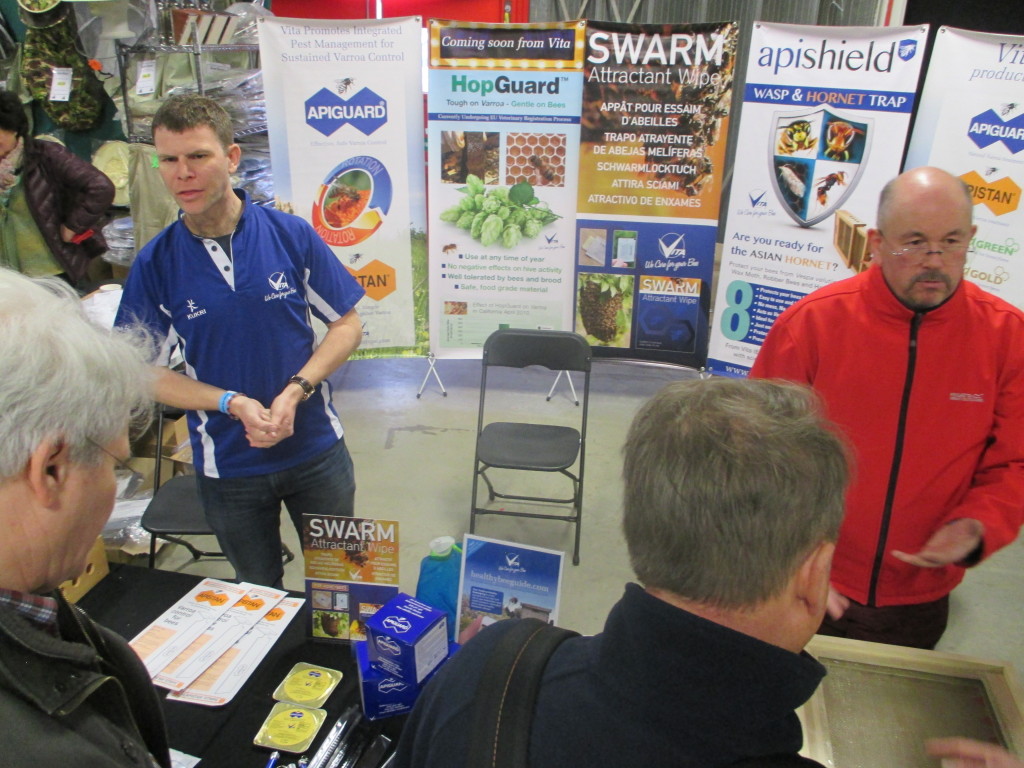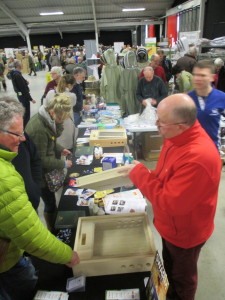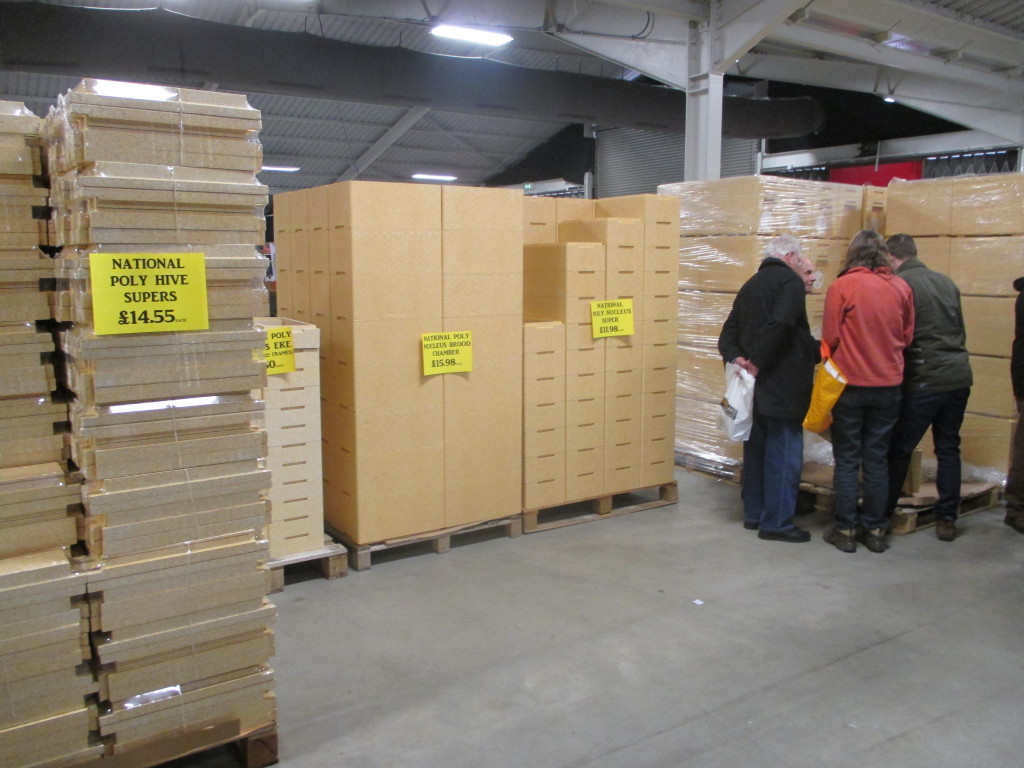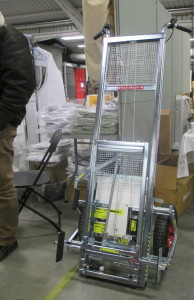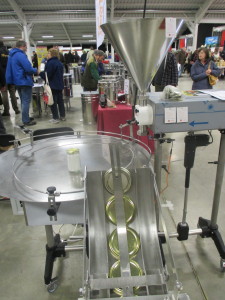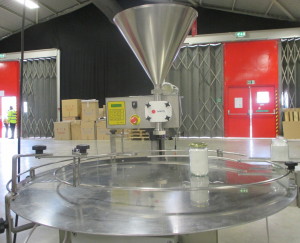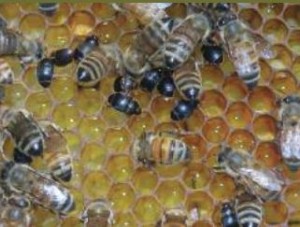Blog – bees, beekeeping & other sticky subjects
The season has started: Bee Tradex
Max, Sebastian and Jon were kept busy at Bee Trade Exhibition 2016 in Stoneleigh, England, last Saturday. They thought it was one of the busiest days they had had at a Vita stand in Britain.
There were lots of enquiries about the Asian hornet trap — and orders were placed and a significant number of repeat purchases. There was good feedback about Apiguard’s ability to control Varroa numbers and Apistan is still being used quite happily by many beekeepers, aware that they need to keep a watchful eye on resistant Varroa.
In a new exhibition hall, there was plenty of room to move around even though there were an enormous number of polystyrene hives on display.
Vita’s next appearance will be at the BBKA Spring Convention on 8-9 April 2016.
Turlough
Vita’s Guest Beekeeper Blogger
Bees, undercrowding & the Allee effect
 Back when I was a young and carefree student, I was occasionally to be found (only after the library had closed, obviously) in one of the local nightclubs. Even in sleepy Exeter, there was always a ‘hot’ place to be, which changed on a regular basis as clubs came in and out of favour.
Back when I was a young and carefree student, I was occasionally to be found (only after the library had closed, obviously) in one of the local nightclubs. Even in sleepy Exeter, there was always a ‘hot’ place to be, which changed on a regular basis as clubs came in and out of favour.
Recently, I’ve been reminiscing about those heady pre-fatherhood days, as I’ve been reading about the Allee effect and its significance for honeybee colonies.
A nightclub can only thrive when busy – we go to clubs to dance (more fun in a full, noisy room) and ‘make new friends’ (much easier in a crowd, so I’m told) – if the club’s too empty even regulars stop going and it quickly closes down.
In the same vein, Warder Allee, an ecologist, proposed that “undercrowding” can limit population growth in the natural world by, for example, making it too hard for an individual to find a partner for cooperative hunting or even a mate.
So how does this relate to bees?
First reported in 2006, there is a now large body of research into so-called ‘Colony Collapse Disorder’ and its possible causes. A strong consensus has built that the phenomenon is the result of a combination of stresses on honeybee colonies. These are typically thought to include Nosema, Varroa and virus infestations, exposure to agricultural pesticides and unnatural experiences such as high hive densities, poor nutrition and regular long-distance movement.
New research, published in the scientific journal PLOS One, sheds further light on the issue and, in my opinion, strengthens the existing hypothesis.
Brian Dennis, professor at the University of Idaho, and William Kemp of the US Department of Agriculture, mathematically modelled colony growth and collapse and showed that population size could be the most important factor.
Dennis and Kemp appear to have confirmed a theory first proposed by Lee Dai, then a physics graduate student at MIT, who discovered in 2012 that when yeast colonies reach a small enough size (which they termed the tipping point), complete collapse is inevitable. Field trials in 2013 confirmed that this effect also occurred in honeybee colonies.
Dennis and Kemp link this with the Allee effect by noting that a honeybee colony functions almost as a single cooperative organism. Sufficient adult workers are required to tend the developing brood, so have a positive feedback loop whereby more adult bees in the hive allows recruitment of more adult workers and an increase in hive population (limited by the rate at which the queen can lay eggs).
Conversely, there is a minimum number of adult bees required, below which mortality is greater than recruitment and the colony quickly collapses. In ordinary conditions, this so-called ‘critical hive size’ is small – a population with as few as 1,000 bees (far less than the 10,000 bees in a typical commercial bee package) can thrive.
Importantly, Dennis and Kemp found that external stressors (including reduced communications or foraging abilities, reduced egg laying, increased stage specific developmental times, increased mortality or decreased cooperative hive protection) can massively raise the critical hive size to above that of a typical colony, resulting in the rapid collapse of previously strong colonies.
Bees, just like students, like a crowd and an “undercrowded” hive will collapse just as quickly as an out of favour nightclub.
VitaFeed Gold is a great way to nourish and strengthen colonies suffering from all kinds of stresses and – unlike the tipple in nightclubs – your bees will still feel great the next day!
Sebastian Owen
Commercial Development Manager at Vita
Waldo’s blog – first tiny steps into beekeeping
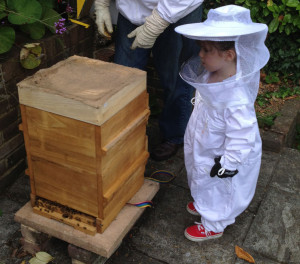 After years of talking about it, I’ve finally taken my first tentative steps towards life as a beekeeper.
After years of talking about it, I’ve finally taken my first tentative steps towards life as a beekeeper.
At times growing up felt like living in a petting zoo (mice, rats, rabbits, hamsters, ponies, sheep, donkeys and a beloved dog), but I don’t remember any training beyond perhaps a short book or a quick word with the pet shop owner. Bees seem different, though, so I’ve started an introduction to beekeeping course, comprising theory and practical sessions.
I hope that this semi-regular column of my journey will remind old hands of the joys and tribulations of starting out as a beekeeper and reassure new starters that you’re not alone.
So, to my experience. The first step was to find my local beekeeping association and sign up for a course. That wasn’t as easy as it sounds. Finding out information about my nearest local association was not straightforward. Despite advertising beginner courses on their website, and despite repeated emails and ‘phone calls, I failed completely to discover the dates or sign up to their putative course.
Back to the drawing board. Luckily I found another beekeeping group just a little further from home and have joined their course.
Speaking with the course tutors, it was clear that a common problem for local associations is a lack of younger beekeepers coming ‘through the ranks’. Any groups facing this problem (I suspect there are many) should take a good look at their website and communication strategy to ensure that wannabe beekeepers aren’t being missed due to a lack of information.
The first session was a fascinating overview of the honeybee and her importance in the ecosystem. This included mention of drone congregation areas, on which I considered myself an expert, having read about them on this website!
We were also shown the key equipment a beekeeper needs and discussed the importance of hygienic behaviour such as using disposable gloves and changing them between hives or (at least) between apiaries.
We covered a huge amount but the main lesson was how much more there remains to learn; it’s going to be a busy (and interesting) few months.
Stay tuned for more updates, especially from April, when we are let loose on real bees to show what we’ve learned!
Waldo
The name of this column is inspired by Waldo McBurney who, in 2006, was recognised as America’s ‘oldest worker’. His profession: beekeeping.
Small Hive Beetle alert in Brazil
Small Hive Beetle has been reported in Brazil.
In March 2015, a swarm of honey bees (Apis mellifera) was captured and held in the apiary of the Useful Insects Laboratory, at the University of São Paulo. Days later, 20 adult females of the small hive beetle (Aethina tumida Murray) were detected in the crate containing the swarm. No larva was found and no apparent damage was observed to the hive.
However, the incident was not reported to the veterinary service until December 2015. Confirmation that they were SHB was confirmed in February 2016. Fortunately, investigation of the original hives did not show the presence of the beetle.
An investigation in a 20 km radius of the original infested hive is underway. In an apiary in a neighboring area, adults of a similar beetle were detected.
It seems that there is a standstill order in place in the area and the investigation has been extended. Beekeepers and related industries are being notified.
Beetle Blaster, from Vita, can act as an early warning alert as well as a trap for the beasts!
What pollinates the coffee blossom?
Have you ever wondered what pollinates your morning coffee?
The smell of coffee blossom in Coorg, the heart of the Mysore coffee area in India, is sublime. It wasn’t even the right season for blossom when I was there, but a few renegade flowers gave a hint of what it must be like in the real flowering season.
I was curious as to what might be the chief honeybee pollinators, but none of the locals could tell me at the time. Fortunately at one place I stayed, some pollination researchers just happened to be the next guests and, courtesy of the host, I now have answers.
“Bees species are indeed the main pollinators of coffee. In Coorg, Apis dorsata is the first pollinator (60% of the pollination), then comes Apis cerana (20%) and Trigona Irridipennis (stingless bee).
“Apis florea only rarely visit coffee and there is almost no Apis mellifera in Coorg. But this can vary in different regions in India.
“It is very difficult to find coffee honey, as bees are usually mixing nectar from different flowers. And the honey harvest is not done just after the end of the coffee flowering but a few months later, when other trees have flowered.”
Turlough
Vita’s Guest Beekeeper Blogger

